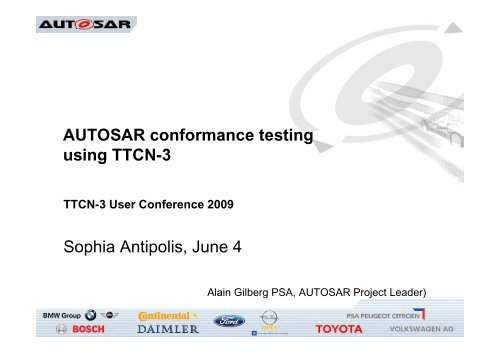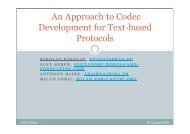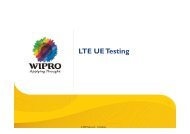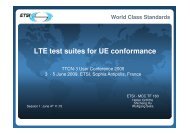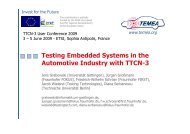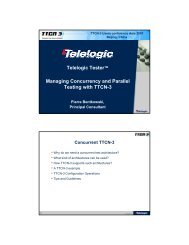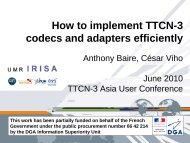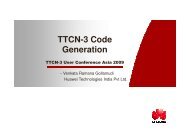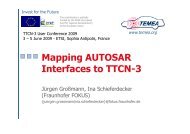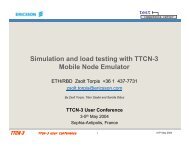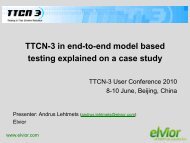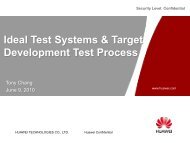Autosar conformance testing using TTCN-3
Autosar conformance testing using TTCN-3
Autosar conformance testing using TTCN-3
You also want an ePaper? Increase the reach of your titles
YUMPU automatically turns print PDFs into web optimized ePapers that Google loves.
AUTOSAR <strong>conformance</strong> <strong>testing</strong><br />
<strong>using</strong> <strong>TTCN</strong>-3<br />
<strong>TTCN</strong>-3 User Conference 2009<br />
Sophia Antipolis, June 4<br />
Alain Gilberg PSA, AUTOSAR Project Leader)
Overview<br />
Introduction to AUTOSAR<br />
Achievements of AUTOSAR<br />
Conformance <strong>testing</strong> with <strong>TTCN</strong>-3<br />
2
Introduction<br />
AUTOSAR, AUTomotive Open System Architecture<br />
De-facto standard, jointly developed by automobile manufacturers, suppliers and<br />
tool developers<br />
More than 150 member companies<br />
“Cooperate on standards, compete on implementation.”<br />
During 6 years the partnership has been<br />
Creating the baseline for software architecture of Automotive ECUs,<br />
Adding major features and<br />
Bringing the standard “On the road”<br />
The ongoing development of products by the member and core partner companies are<br />
providing a unique feedback loop into the development of the standard itself.<br />
3
Main objective of AUTOSAR: Managing Complexity<br />
by Exchangeability and Reuse of Software Components<br />
OEM b<br />
OEM a<br />
Platform b.1<br />
Platform b.2<br />
Platform b.n<br />
Exchangeability<br />
between<br />
supplier‘s<br />
solutions<br />
OEM c<br />
Platform a.1<br />
Platform a.2<br />
Platform a.n<br />
Exchangeability<br />
between<br />
manufacturer‘s<br />
applications<br />
OEM f<br />
Supplier A<br />
Chassis<br />
Safety<br />
Body/Comfort<br />
Multimedia*<br />
OEM e<br />
Supplier C<br />
Body/Comfort<br />
Powertrain<br />
Telematics<br />
Multimedia*<br />
Supplier B<br />
Chassis<br />
Safety<br />
Telematics<br />
Multimedia*<br />
Platform c.1<br />
Platform c.2<br />
Platform c.n<br />
OEM d<br />
Platform d.1<br />
Platform d.2<br />
Platform d.n<br />
Platform f.1<br />
Platform f.2<br />
Platform f.n<br />
Note on Multimedia: Application interfaces only<br />
Platform e.1<br />
Platform e.2<br />
Platform e.n<br />
Exchangeability<br />
between vehicle<br />
platforms<br />
4
AUTOSAR has standardized the software architecture of ECUs<br />
Yesterday<br />
Software<br />
AUTOSAR<br />
Application Software<br />
Hardware<br />
AUTOSAR<br />
Hardware<br />
standardized<br />
HW-specific<br />
Hardware- and software will be widely independent of each other.<br />
Development processes will be simplified.<br />
This reduces development time and costs.<br />
Reuse of software increases at OEM as well as at suppliers.<br />
This enhances also quality and efficiency.<br />
5
AUTOSAR – Core Partners and Members<br />
Status: 29th March 2009<br />
9 Core Partner<br />
7 Development<br />
Member<br />
56 Premium Member<br />
84 Associate Member<br />
14 Attendees<br />
General<br />
OEM<br />
Generic<br />
Tier 1<br />
Standard<br />
Software<br />
Tools and<br />
Services<br />
Semiconductors<br />
Up-to-date status see: http://www.autosar.org<br />
6<br />
10th Feb. 2009<br />
Overview on AUTOSAR Members
Development Approach: 2004-2008<br />
Objectives<br />
Objectives<br />
Tasks Tasks<br />
Releases Releases<br />
Usage Usage<br />
Project objectives<br />
and<br />
concepts<br />
Architecture,<br />
Specifications,<br />
Validation<br />
Release 1.0<br />
05/2005<br />
Proof<br />
of concept<br />
New features<br />
and<br />
continuous improvements<br />
Architecture,<br />
Specifications,<br />
Validation<br />
Release 2.0<br />
05/2006<br />
Release 2.1<br />
01/2007<br />
Release 3.0<br />
12/2007<br />
AUTOSAR<br />
on the road<br />
OBD<br />
Specifications<br />
Release 3.1<br />
08/2008<br />
Complementary concepts<br />
and<br />
Conformance tests<br />
Architecture,<br />
Specifications,<br />
Validation<br />
Release 4.0<br />
11/2009<br />
7
The AUTOSAR Roll Out Plan (2008 - 2012)<br />
8
AUTOSAR Main Working Topics<br />
Architecture<br />
Application<br />
Interfaces Methodology<br />
Architecture<br />
Application<br />
Interfaces Methodology<br />
Architecture:<br />
Software architecture including a complete basic software<br />
stack for ECUs – AUTOSAR Basic Software – as an<br />
integration platform for hardware independent software<br />
applications.<br />
Methodology:<br />
Description templates and exchange formats to enable a<br />
seamless configuration process of the basic software stack<br />
and the integration of application software in ECUs. Guidelines<br />
how to use this framework.<br />
Architecture<br />
Application<br />
Interfaces Methodology<br />
Application Interfaces:<br />
Specification of interfaces of typical automotive applications<br />
from all domains in terms of syntax and semantics, which<br />
should serve as a standard for application software.<br />
9
Layered Architecture<br />
Application<br />
Software<br />
Component<br />
AUTOSAR<br />
Interface<br />
Actuator<br />
Software<br />
Component<br />
AUTOSAR<br />
Interface<br />
Sensor<br />
Software<br />
Component<br />
AUTOSAR<br />
Interface<br />
AUTOSAR<br />
Software<br />
..............<br />
AUTOSAR Runtime Environment (RTE)<br />
Application<br />
Software<br />
Component<br />
AUTOSAR<br />
Interface<br />
Basic Software<br />
Standardized<br />
Interface<br />
Operating<br />
System<br />
Standardized<br />
Inteface<br />
Standardized<br />
Standardized<br />
AUTOSAR Services Layer Interface<br />
Interface<br />
Services<br />
Communication<br />
Standardized Standardized<br />
InterfaceECU Abstraction Interface Layer<br />
Basic Software<br />
Microcontroller Abstraction Layer<br />
ECU-Hardware<br />
AUTOSAR<br />
Interface<br />
ECU<br />
Abstraction<br />
Standardized<br />
Interface<br />
Standardized<br />
Interface<br />
Microcontroller<br />
Abstraction<br />
Complex<br />
AUTOSAR Drivers<br />
Interface<br />
Complex<br />
Device<br />
Drivers<br />
10
Architecture en couches<br />
Application<br />
Software<br />
Component<br />
AUTOSAR<br />
Interface<br />
Actuator<br />
Software<br />
Component<br />
AUTOSAR<br />
Interface<br />
Sensor<br />
Software<br />
Component<br />
AUTOSAR<br />
Interface<br />
AUTOSAR<br />
Software<br />
..............<br />
AUTOSAR Runtime Environment (RTE)<br />
Application<br />
Software<br />
Component<br />
AUTOSAR<br />
Interface<br />
System Services<br />
Memory Services<br />
Communication<br />
Services<br />
I/O Hardware<br />
Abstraction<br />
Complex<br />
Drivers<br />
Basic Software<br />
Onboard Device<br />
Abstraction<br />
Microcontroller<br />
Drivers<br />
Memory Hardware<br />
Abstraction<br />
Memory Drivers<br />
Communication<br />
Hardware<br />
Abstraction<br />
Communication<br />
Drivers<br />
I/O Drivers<br />
ECU-Hardware<br />
11
Details on the memory stack at basic software module level<br />
12
AUTOSAR Méthodology (1/2)<br />
Sofware Component<br />
Modèle de description<br />
Modèle de description<br />
Template<br />
d’un module applicatif<br />
d’un module applicatif<br />
Application sofware component:<br />
Ports/Interfaces<br />
Internal behavior<br />
Tooling<br />
System Template<br />
Networks<br />
Communication matrix<br />
System constraints<br />
Topology:<br />
ECUs, Resources<br />
Communication ports<br />
Modèlede ECU de resources description<br />
du du Template Hardware<br />
System Configuration<br />
ECU Configuration<br />
RTE Generation<br />
Basic Software Configuration<br />
13
Méthodologie AUTOSAR (2/2)<br />
SW-C<br />
Description<br />
AUTOSAR<br />
Application<br />
SW-C 1<br />
SW-C<br />
Description<br />
AUTOSAR<br />
Application<br />
SW-C 2<br />
SW-C<br />
Description<br />
AUTOSAR<br />
Application<br />
SW-C 3<br />
SW-C<br />
Description<br />
…<br />
AUTOSAR<br />
Application<br />
SW-C n<br />
Virtual<br />
Functional<br />
Bus<br />
System<br />
constraints<br />
Description<br />
ECU<br />
Descriptions<br />
Tools supporting<br />
deployment of<br />
SW components<br />
ECU 1<br />
AUTOSAR<br />
SW-C 1<br />
ECU m<br />
AUTOSAR<br />
SW-C n<br />
RTE<br />
Basic<br />
Software<br />
RTE<br />
Basic Software<br />
AUTOSAR<br />
SW-C 3<br />
ECU 2<br />
AUTOSAR<br />
SW-C 2<br />
RTE<br />
Basic<br />
Software<br />
14
Application Interfaces<br />
WPII-10.1 Body Electric<br />
Keyless Access<br />
CentralLocking InteriorLight BodySensor<br />
Components<br />
AUTOSAR<br />
RemoteKey KeylessAccess KeyPad<br />
Application<br />
Software<br />
Component<br />
ProfileManager<br />
><br />
><br />
…<br />
><br />
><br />
System<br />
Sub-system<br />
SW-<br />
Component<br />
Standardized application interface<br />
AUTOSAR standardizes not all interfaces of a SW-component,<br />
only the widely required interfaces.<br />
15
To ease the re-use of software components across several OEMs, AUTOSAR<br />
proceeds on the standardization of the application interfaces agreed among the<br />
partners.<br />
Example<br />
2nd Yaw<br />
Rate Controller<br />
Base Sensor Signals<br />
Ínterface of ESP and<br />
external yaw rate<br />
controller<br />
I 6<br />
System-level Brake<br />
Actuator Interface<br />
I 7<br />
ESP-Sensors<br />
I 1<br />
ESP<br />
SW-Component<br />
Brake Actuator<br />
Interface of ESP<br />
and VLC<br />
I 4<br />
I 2<br />
I 3<br />
I 5<br />
Vehicle<br />
Longitudinal<br />
Controller<br />
Standard Signals<br />
from ESP<br />
Information signals<br />
from other functions /<br />
domains<br />
Command signals to<br />
other functions /<br />
domains<br />
Standardized application interfaces on<br />
system level<br />
(ESP-system, chassis domain)<br />
Data Type Name<br />
Description<br />
Data Type<br />
Integer Range<br />
Physical Range<br />
Physical Offset<br />
Unit<br />
…<br />
Remarks<br />
…<br />
Data Type Name<br />
YawRateBase<br />
Yaw rate measured along vehicle z- axis<br />
(i.e. compensated for orientation).<br />
Coordinate system according to ISO<br />
8855<br />
S16<br />
-32768..+32767<br />
-2,8595..+2,8594<br />
0<br />
rad/sec<br />
….<br />
This data element can also be used to<br />
instantiate a redundant sensor interface.<br />
Range might have to be extended for<br />
future applications (passive safety).<br />
RollRateBase<br />
16
Integrated Master Table as Engineering Tool<br />
automatic<br />
generation<br />
XML<br />
representation<br />
as standard<br />
document<br />
import<br />
RainSensing<br />
RainSensor<br />
AutoWipingEvaluator<br />
OutsideBrightness<br />
ReqRainSensing<br />
ReqRainSensingSensitivity<br />
StaFrontWasher<br />
StaFrontWiper<br />
VehicleLongitudinalSpeed<br />
0<br />
1<br />
2<br />
3<br />
4<br />
5<br />
StaRainAmount<br />
DispRainSensActive<br />
0 0<br />
1<br />
0<br />
1<br />
2<br />
3<br />
4<br />
5<br />
StaRainAmount ErrRainSensing<br />
OutsideBrightness<br />
ReqFrontAutoWiping<br />
ReqRainSensing<br />
ReqRainSensingSensitivity<br />
StaFrontWasher<br />
StaFrontWiper<br />
VehicleLongitudinalSpeed<br />
0<br />
1<br />
0<br />
1<br />
1<br />
ErrRainSensing<br />
ReqFrontAutoWiping<br />
DispRainSensActive<br />
Graphical representation /<br />
Import to AUTOSAR compliant modeling tool<br />
17
A validation project was set up to validate the results of AUTOSAR<br />
AUTOSAR<br />
Specifications<br />
AUTOSAR<br />
Concepts &<br />
Methodology<br />
TriCore 1766 (32 Bit)<br />
Hardware Platforms<br />
HCS12X (16 Bit)<br />
Validator<br />
dealt with …<br />
Integration<br />
by independent<br />
companies<br />
Module Implementations<br />
&<br />
ECU Configuration Tools<br />
18
Major Achievements of Releases 3.0/3.1<br />
Architecture<br />
Application<br />
Interfaces Methodology<br />
Architecture (BSW and RTE):<br />
High stability of architecture and functionality<br />
Concepts for wake-up and bus state management incorporated<br />
On Board Diagnostic introduced in Release 3.1<br />
Commercial implementations of BSW and RTE available<br />
Industrially useable<br />
Architecture<br />
Application<br />
Interfaces Methodology<br />
Methodology:<br />
<br />
Improved implementation/configuration methodology<br />
by new BSW Module Description Template<br />
Good progress in the consistency of templates starting from the<br />
system view down to the ECU configuration<br />
Commercial tooling for AUTOSAR available<br />
Major cornerstones set<br />
Architecture<br />
Application<br />
Interfaces Methodology<br />
Application Interfaces: First set of cross-domain standardization<br />
<br />
<br />
First vehicle-wide specification of application interfaces<br />
Integration procedures available for further interface specifications<br />
19
Release 4.0: main focus<br />
Architecture and Basic Software<br />
Functional safety, error handling harmonization,<br />
Evolutions of the communication stack<br />
Architectural extensions<br />
Conformance tests specifications for basic software modules<br />
Methodology<br />
Variant handling and calibration<br />
Timing model<br />
Improvement of templates<br />
Application interfaces<br />
Continuous development in the domains of<br />
Body, Powertrain, Chassis, Passive Safety, Telematics/Multimedia/HMI<br />
20
Conformance <strong>testing</strong> in the AUTOSAR project<br />
The AUTOSAR standard is focussed on<br />
The use by all partners (OEM, Tier 1s, software vendors) of a common<br />
architecture<br />
The standardization of interfaces for basic software modules, RTE and<br />
application interfaces<br />
A high configurability to cover all the needs and to enable scalability to<br />
different vehicle platforms<br />
The <strong>conformance</strong> <strong>testing</strong> has been a target from the very beginning to<br />
enable those objectives of transferability and reuse<br />
The Workpackage #20 has been set up to build the <strong>conformance</strong> <strong>testing</strong><br />
process<br />
A specific Workpackage #2.2 is in charge of the development of the<br />
<strong>conformance</strong> tests<br />
21
Conformance <strong>testing</strong> objectives<br />
The <strong>conformance</strong> of BSW implementations<br />
to the AUTOSAR specifications is a basic<br />
condition for<br />
Interoperability and reuse<br />
<strong>using</strong> AUTOSAR trademark<br />
They are developed for basic software<br />
modules and for the RTE<br />
Conformances tests will be part of the<br />
Release 4.0<br />
22
Conformance Testing for AUTOSAR products<br />
Conformance test agencies (CTA) are<br />
entitled companies for delivering<br />
<strong>conformance</strong> attestations on<br />
AUTOSAR implementations<br />
Conformance Test Agencies (CTA):<br />
produce/perform <strong>conformance</strong> test<br />
suites (CTS) derived from the<br />
<strong>conformance</strong> test specifications<br />
Different paths are defined for<br />
<strong>conformance</strong> from 3rd party<br />
attestation to self declaration<br />
CTS from<br />
CTA<br />
Support from<br />
CTA<br />
Attestation<br />
from CTA<br />
Third party<br />
attestation<br />
Product supplier<br />
AUTOSAR conform product<br />
First party declaration<br />
Path A Path B Path C<br />
Accredited<br />
PS<br />
CTS from CTA<br />
Self-<br />
Declaration<br />
Accredited<br />
PS<br />
Own CTS<br />
Self-<br />
Declaration<br />
PS<br />
Path D<br />
Self-<br />
Declaration<br />
23
AUTOSAR Implementation Conformance Classes (ICC)<br />
3 Implementation Conformance Classes<br />
ICC3: RTE + all BSW modules separately.<br />
Application Layer<br />
<br />
Maps full AUTOSAR module granularity<br />
AUTOSAR Runtime Environment (RTE)<br />
<br />
superset of all features in AUTOSAR<br />
System Services<br />
Memory<br />
Services<br />
Communication<br />
Services<br />
I/O Hardware<br />
Abstraction<br />
Complex<br />
Drivers<br />
ICC2: RTE + BSW bundled into separate clusters.<br />
Maps existing solutions and clusters<br />
(e.g. Memory-Cluster includes several<br />
modules)<br />
Onboard Device<br />
Abstraction<br />
Microcontroller<br />
Drivers<br />
Memory<br />
Hardware<br />
Abstraction<br />
Memory<br />
Drivers<br />
Communication<br />
Hardware<br />
Abstraction<br />
Communication<br />
Drivers<br />
I/O Drivers<br />
Can Driver<br />
ICC1: RTE + BSW in one single cluster:<br />
<br />
<br />
<br />
Can be used for migrating to AUTOSAR.<br />
Can be used to embed existing proprietary<br />
solutions.<br />
Offers the highest level of integration.<br />
Microcontroller<br />
24
Conformance Test Specification process<br />
Objectives<br />
CT methodology: How to test which test objects and features?<br />
CT specification: How to organize the specification process?<br />
CT verification: How to verify the quality of the tests?<br />
Scope<br />
CT Specification on BSW, ICC3 level,<br />
Approach<br />
Analysis and refinement of design specifications (SWS)<br />
Identification and classification of SWS items<br />
Design and specification of <strong>conformance</strong> tests<br />
Verification of test specifications<br />
Focus<br />
25
Conformance Test Specification process<br />
Roles: Test designer, Test implementer, Test verification implementer, Test assessor<br />
Phases: Analysis, Design, Implementation, Verification on dev machines and target<br />
platforms<br />
Supporting disciplines, e.g.<br />
Requirements management, Configuration management<br />
26
Conformance Test Methodology<br />
Check test objects for <strong>conformance</strong> to design specifications (SWS)<br />
Conformance tests<br />
Primarily automatable, dynamic tests<br />
Black-box unit tests of valid configurations<br />
Functional properties of provided and required operations<br />
Abstract test cases specified in <strong>TTCN</strong>-3<br />
Implementation Conformance Statement (ICS):<br />
Is used to adapt the test suite to the actual variant of the test object<br />
27
Conformance Testing Methodology<br />
Test scope<br />
Interfaces, behavior and configurations<br />
Functional tests of individual basic software<br />
modules<br />
Requirements on tests<br />
Tests case specifications shall be stringent,<br />
accurate and non ambiguous<br />
Executable test procedures shall be derived<br />
automatically from tests specifications<br />
28
Rationale for choosing <strong>TTCN</strong>-3 for test specifications<br />
<strong>TTCN</strong>-3 is used for dynamic tests<br />
Abstract notation for test specifications and stubs<br />
Tests procedures can automatically be derived from test specifications<br />
Test specifications delivered to CTAs by AUTOSAR are non ambiguous<br />
Test suites developed by CTAs will keep the same behaviour.<br />
Boundary conditions<br />
The tooling available on the market should behave the same wrt the <strong>TTCN</strong>-<br />
3 notation<br />
<strong>TTCN</strong>-3 rules had to be elaborated in order to fit to the tools capabilities<br />
29
Strategy for development<br />
Target is the AUTOSAR R4.0<br />
Synchronize the development of SWS and CT specs<br />
Anticipate with R3.0 modules<br />
Start with modules where less changes are expected<br />
Improvements of SW specifications due to CT are included<br />
SWS development<br />
R3.0 R4.0<br />
CT Specs development<br />
1 st set<br />
(R3.0)<br />
2 nd set<br />
(R3.0)<br />
3 rd set<br />
(R4.0)<br />
4 th set<br />
+ Update<br />
(R4.0)<br />
30<br />
25 May 2009<br />
Conformance Testing-13th EB meeting
Outcome from the CTSpecs project<br />
Analysis of 70% of the BSW modules<br />
~5000 requirements have been already analyzed<br />
37% are testable by behavioral tests<br />
Improvement of SW specifications<br />
Atomic requirements, testable, local to this module<br />
Some functional bugs have been fixed too<br />
Coverage (relevant for CT)<br />
Hardware dependent & real time dependent requirements are considered not testable<br />
Test coverage is depending on the modules<br />
Maximum: 100%<br />
Average: 84%<br />
Minimum: 61%<br />
Test validation<br />
All the test cases has been validated on a simulated environment<br />
A feed back loop has been established with pilot CTAs<br />
31<br />
25 May 2009<br />
Conformance Testing-13th EB meeting
Conclusion<br />
1<br />
The AUTOSAR development partnership has brought to reality a<br />
unique and worldwide standard,<br />
2<br />
AUTOSAR products are now available on the market,<br />
3<br />
Conformance test has already made the specifications more robust<br />
4<br />
Conformance test will help us to keep the integrity of the standard<br />
32
Thank you for your attention!<br />
http://www.autosar.org<br />
request@autosar.org<br />
Published version of<br />
AUTOSAR Release 3.1<br />
33


